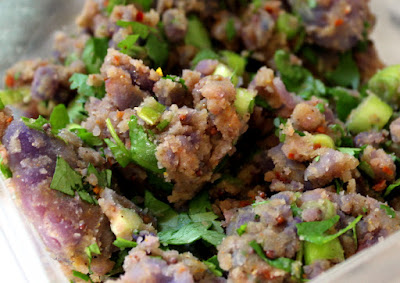"Potato salad?" said the bite-offerer, descriptively.
"Um," I replied.
I paused. I'm not such a fan of potato salad, after all. I believe in the overcooking of all potatoes always forever, and potato salad potatoes are so frequently al dente. And then there's the mayonnaise thing. And the cold thing. And the lack of any hint of flavor drama.
And yet.
Maybe this was THE potato salad. Maybe this would be the moment at which the summertime picnics of my life would change course magically and irrevocably in a blissful epiphany of potato salad perfection. Maybe the secret ingredient was hidden inside this very forkful.
I forked.
I chewed.
I marveled at how very much this potato salad tasted exactly like every other potato salad I had ever tried in the history of summertime picnics.
Enough was enough. I was tired of being a passive potato salad bystander, sitting wistfully on the sidelines of summertime picnic history. It was time to act. It was time to make this.
It is in many ways, as you will see, the anti-potato salad potato salad. No mayonnaise. No white potatoes. Bursting with flavor. And best of all, delightfully overcooked.
Ingredients
1.25 lbs yellow or purple potatoes
Rounded 1/2 tsp black or yellow mustard seeds, lightly toasted in a pan until fragrant (about 30 seconds)
 4 tbsp olive oil
4 tbsp olive oil2 tsp red wine vinegar
1/2 tsp grated fresh ginger
Scant 1 tsp good quality curry powder
1/4 tsp kosher salt
Handful cilantro, chopped (about 2 1/2 tbsp)
Small handful baby arugula, chopped
2-3 scallions, sliced
Bring a pot of water to boil for the potatoes, then boil 15-25 minutes until the skins split and the potatoes are very tender (i.e., delightfully overcooked). Drain, rinse with cold water or an ice bath to cool, and peel (the skins should pull off easily).
Whisk together the olive oil, vinegar, curry powder, ginger, and salt. Put the peeled potatoes in a bowl and break apart into bite-sized pieces with a fork, then drizzle with the curry mixture and toss to coat evenly. Sprinkle in the mustard seeds, cilantro, arugula, and scallions, tossing gently to mix evenly. Adjust seasonings to taste (the spice of the curry, tang of the vinegar, and cilantro-y-ness of the cilantro should balance each other out -- if one seems to be missing from the flavor, add a bit more. If the flavor just seems muted overall and you want to make it louder, sprinkle in a bit more salt).
Cover the bowl and leave in the fridge to chill while the flavors blend until you're ready to eat.
Serves 3-4.











































